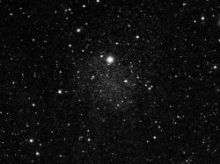44 million stars and counting: Astronomers play Snap and remap the sky

(Phys.org) —Tens of millions of stars and galaxies, among them hundreds of thousands that are unexpectedly fading or brightening, have been catalogued properly for the first time.
Professor Bryan Gaensler, Director of the ARC Centre of Excellence for All-sky Astrophysics (CAASTRO) based in the School of Physics at the University of Sydney, Australia, and Dr Greg Madsen at the University of Cambridge, undertook this formidable challenge by combining photographic and digital data from two major astronomical surveys of the sky, separated by sixty years.
The new precision catalogue has just been published in The Astrophysical Journal Supplement Series. It represents one of the most comprehensive and accurate compilations of stars and galaxies ever produced, covering 35 percent of the sky and using data going back as far as 1949.
Professor Gaensler and Dr Madsen began by re-examining a collection of 7400 old photographic plates, which had previously been combined by the US Naval Observatory into a catalogue of more than one billion stars and galaxies.
The astronomers then set out to painstakingly match all the objects in this catalogue with more modern measurements from the Sloan Digital Sky Survey. Using very stringent criteria to be absolutely sure of a match, Professor Gaensler and Dr Madsen produced a final catalogue of 44 million stars and galaxies that had definitely been seen twice: both in old photographs and with modern cameras.
"Thanks to clever computer algorithms, we thankfully didn't need to inspect all billion stars and galaxies individually," said Professor Gaensler. "But even so, processing the data and then testing everything to make sure we got it right took us more than a year."
"This cosmic game of Snap provides two important breakthroughs. First, it gives far more accurate measurements of the brightness of each individual star than had ever previously been possible. Second, by comparing two photographs of each star taken up to sixty years apart, it becomes easy to identify stars whose brightness has slowly changed."
The researchers found that approximately 250,000 objects in their new catalogue, or about 0.6 percent of all the stars in the sky, change in their brightness by quite large amounts over a human lifetime.
Some of these discoveries appear to be new cases of stars known as 'Mira variables': red giants in a late stage of stellar evolution that pulsate in brightness before collapsing into a dense white dwarf. Other stars are likely to be exhibiting rare and unusual behaviour that has never previously been identified.
"What is special about this catalogue is that it carefully combines historical data with modern measurements. This is a unique way to study objects that gradually change over years or even decades," says Dr Madsen.
The researchers are making their entire catalogue public on the internet, in the lead-up to the next generation of telescopes designed to search for changes in the night sky, , such as the Panoramic Survey Telescope and Rapid Response System in Hawaii and the SkyMapper telescope in Australia.
"This catalogue comes at just the right moment for the next generation of telescopes. Using our measurements, astronomers who find interesting new stars in the sky can essentially go back in time, and see what the object they're studying was doing 60 years earlier," said Professor Gaensler.
Provided by University of Sydney




















